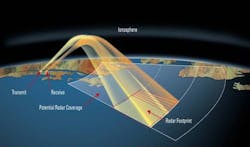Researchers ask industry to develop signal processing algorithms for ship-tracking over-the-horizon radar
ARLINGTON, Va. – U.S. military researchers are asking industry for signal processing for ocean ship and boat tracking using surface-wave over-the-horizon radar (SWOTHR) and environmental characterization.
Officials of the U.S. Defense Advanced Research Projects Agency (DARPA) in Arlington, Va., has issued a solicitation (DARPA-PA-23-03-11) for the Defense Applications of Innovative Remote Sensing (DAIRS) project.
Primary emphasis will be in the high frequency (HF) band nominally at 4 to 15 MHz. Key applications in this frequency band are SWOTHR for aircraft, ship, and boat tracking, oceanographic SWOTHR, and sounding for ionospheric characterization.
DAIRS has three focus areas: passive noise radar; clutter mitigation; and classification. The project will last as long as 15 months, and has funding of as much as $2 million.
Related: Radar keeps a surveillance eye on the battlefield
Passive noise radar will build on the body of work covering passive remote sensing to investigate and develop techniques for passive noise radar, without the need to know or estimate the temporal properties of the received waveforms.
Clutter mitigation will develop methods that are based on the physics of surface wave and spread clutter propagation to mitigate unwanted spread-Doppler clutter.
DAIRS will explore signal processing with nontraditional methods to enable systems that provide completely passive radar and remote sensing capabilities using indigenous noise that in the environment.
The project also will select signals that propagate via stable surface wave paths while rejecting signals received via disturbed ionospheric paths, generate watercraft features, and provide approaches for classification.
For passive noise radar, the program will explore environmental sensing to detect ships and aircraft using the HF band, as well as determine sea state or ocean surface currents, and the height of ionospheric return versus frequency. Signal processing techniques will help reduce the signal-to-clutter-and-noise ratio (SCNR).
Classification will explore relatively long observation periods, and multi-frequency and multi-angle observation processing to classify maritime vehicles. This solicitation centers on algorithms and methods for the three focus areas, and is not to fund a large-scale test instrumentation development or field test campaign.
Related: Radar technology looks to the future
DAIRS will have a six-month first phase and a nine-month second phase. The first phase will develop mid-latitude data with initial algorithms, and the second phase will refine algorithm and processing techniques.
Companies interested should submit unclassified proposals no later than 10 July 2024 to the DARPA Broad Agency Announcement Portal online at https://baa.darpa.mil.
Email questions or concerns to Frank Robey, the DARPA DAIRS program manager, at [email protected]. More information is online at https://sam.gov/opp/9e3ce0e36e314855b72d091b9017742e/view.
About the Author
John Keller
Editor-in-Chief
John Keller is the Editor-in-Chief, Military & Aerospace Electronics Magazine--provides extensive coverage and analysis of enabling electronics and optoelectronic technologies in military, space and commercial aviation applications. John has been a member of the Military & Aerospace Electronics staff since 1989 and chief editor since 1995.
